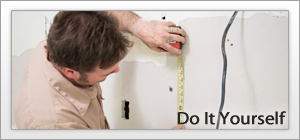|
Learning Centre
|
Cleaning Acoustic Ceiling Tiles
How To Clean Ceiling TilesCeiling Tile Cleaning Cleaning ceiling tiles and ceiling panels really depends on the material of their composition. If your ceiling tile was already in place when you moved in and you’re not sure which type of ceiling tile or panels you have, you can make assumptions based on the texture of the material to safely clean the ceiling. Porous Ceiling TilesThese tiles are a type of acoustic (sound-absorbing) tile found in most commercial buildings. They are also found in many older homes. These ceiling tiles can be difficult to clean because they are made of a fibrous material with holes in them. They are not sealed and smooth. Dusting and vacuuming these tiles can prevent dirt build-up and stains that will require replacing tiles.
If there are spots, dirt, or stains that you notice after dusting, attack them with a dry sponge, available through most janitorial suppliers. It’s a rubber sponge that is usually very effective in places where you can’t use water. If you can’t get out a stain, you’ll probably have to replace a tile. Luckily, these are usually inexpensive tiles to replace. Tin Ceiling TilesTin Tiles are beautiful ceiling tiles, usually with intricate designs. They can have a polished, metallic appearance or be painted. They are usually found in older homes or newer homes where there are antique lovers. Cleaning them is simple. They should be dusted as necessary with a soft, cotton dust mop, feather duster, or static duster. Disposable dusting sheets can sometimes scratch the finish, so don’t use them. When tin ceiling tiles appear dull or dirty, a mild solution of dishwashing liquid and water will clean them and bring back a finished appearance. Tin tiles don’t usually rust, but if you see signs of rust, you can gently scrape the rust with very fine grade steel wool. Finished Synthetic Ceiling TilesCeiling tiles these days can have facings that are made of things like vinyl or PVC, but they have beautiful finishes that look like metal, plaster, or even decorative wood surfaces with detailed, raised designs. These surfaces are usually waterproof and very easy to clean. Dust with a dust mop, feather duster, or static duster. You shouldn’t have to clean them very often. When they appear dull or dirty, you can use a dish soap solution or general household cleaning solution to clean them. The luster will return once the tiles have been cleaned. Sheetrock Tiles or PanelsThese ceiling tiles or panels are simply wallboard or sheetrock that has been either vinyl coated or just painted. The tiles can sometimes be sprayed with popcorn surfacing. Care for these tiles is basically the same as for a normal ceiling. You should dust for cobwebs and dirt with a feather duster, static duster, or vacuum attachment. Cleaning these tiles can be difficult unless there is vinyl coating or enamel paint. You should gently use a dry sponge when it’s a surface you should not get wet. The good thing about these tiles is that they can be easily repainted if you can’t get out the dirt or stain. Water Damage on Ceiling TilesWater stains are usually caused by a pinhole plumbing leak, roof leak, or other plumbing problem from the level above. Before you try to fix the stain, make sure that whatever was causing the problem is fixed completely. If the tile can be removed, it should be so you can inspect damage on the backside of the tile. Depending on what the backing material is, you might want to clean the damage or apply a sealer to avoid mold. If the surface of the damaged ceiling tile is porous or painted, you should try removing the stain with a dry sponge. If this doesn’t work on a porous tile, you might have to replace the tile. If you decide to replace the tile, you might as well try a harsher cleaning solution: 1/4 bleach in 1 quart of water. Use a soft cloth or sponge to dab (nor rub) the surface with this solution. This solution can also be used on painted ceiling tiles, but it might ruin the finish of tiles painted with flat latex paint. If the water stain remains, you will have to repaint the surface of painted tiles. Before you do, you should use a sealer, or the stain will show through the new layer of paint
|
At Costa Building Supplies Ltd., our professional team specializes in supplying the highest quality of drywall in Vaughan and Cambridge. Visit us at costabuildingsupplies.com if you are looking for affordable drywall in Cambridge, Vaughan and the surrounding areas.




